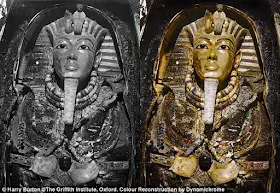Πίσω
από τον τάφο του Τουταγχαμών υπάρχουν δύο θάλαμοι σύμφωνα με το σκάνερ. The
walls of King Tutankhamun’s burial chamber are painted with scenes depicting
the burial rituals of the young pharaoh. Radar scans suggest the presence of
open spaces behind the walls. PHOTOGRAPH BY BRANDO QUILICCI, NATIONAL
GEOGRAPHIC
«Είναι 90% πιθανόν να υπάρχουν δύο κρυμμένοι
θάλαμοι πίσω από τους τοίχους του τάφου του Τουταγχαμών στο Λούξορ»
ανακοίνωσε το υπουργείο Αρχαιοτήτων της Αιγύπτου, κάνοντας λόγο για
προκαταρκτικά αποτελέσματα ανάλυσης που έγινε με σύγχρονα μέσα.
Η
ανακάλυψη του τάφου της Νεφερτίτης θα μπορούσε να λύσει κι ένα μεγάλο
οικογενειακό μυστήριο, αφού ορισμένοι αιγυπτιολόγοι υποστηρίζουν ότι η
πανέμορφη βασίλισσα ήταν μητέρα του Τουταγχαμών. Neferneferuaten
Nefertiti - or Queen Nefertiti - was the wife and 'chief consort' of King
Akhenaten, an Eyptian Pharoah during 14th century BC, one of the wealthiest era
in Ancient Egypt (bust pictured). Queen Nefertiti's name means "a
beautiful woman has come".
Αυτή
η σχεδόν βεβαιότητα ενισχύει την άποψη του βρετανού αρχαιολόγου και
αιγυπτιολόγου Νίκολας Ριβς, ο οποίος διαβεβαιώνει ότι ίσως πρόκειται για τον
ηλικίας 3.300 και πλέον ετών τάφο της βασίλισσας Νεφερτίτης.
New evidence
supports the theory that King Tut's tomb has a hidden chamber, according to
experts who this week completed the first-ever radar scanning of walls inside.
Japanese radar specialist Watanabe Hirokatsu, accompanied by Egyptian archaeologists,
performed the scanning in the tomb of Tutankhamun, pharaoh of Egypt's 18th
dynasty, who died at the age of 17. National Geographic grantee and British
Egyptologist Nicholas Reeves earlier this year promoted the theory that the
hidden chamber could be the burial place of Nefertiti, the mother-in-law of
Tutankhamun, and who is believed to have ruled as a female pharaoh, also during
Egypt's 18th dynasty. While sight verification, possibly with a small remote
camera, is under consideration for Egyptian officials, for now, Antiquities
Minister Mamdouh ElDamaty says, "We believe that there could be another
chamber."
Ο
αιγύπτιος υπουργός Μαμντούχ αλ-Νταμάτι κλίνει μάλλον προς την εκδοχή ο τάφος να
ανήκει σε άλλη σύζυγο του φαραώ Ακενατών, πατέρα του Τουταγχαμών.
Δύο
κρυμμένοι θάλαμοι, ένα μεγάλο μυστήριο
Hirokatsu Watanabe,
a radar specialist from Japan, pushes his specially modified Koden-brand
machine along the north wall of Tutankhamun’s burial chamber during radar
scanning last fall. PHOTOGRAPH BY BRANDO QUILICCI, NATIONAL GEOGRAPHIC
Τα
προκαταρκτικά αποτελέσματα μιας μελέτης με ραντάρ που διεξήχθη από τον ιάπωνα
ειδικό Χιροκάτσου Βατανάμπε αποκαλύπτουν ότι «είναι 90% πιθανόν να υπάρχουν δύο θάλαμοι κρυμμένοι πίσω από τον τάφο
του Τουταγχαμών» δήλωσε ο υπουργός σε συνέντευξη Τύπου στο Κάιρο.
Pointing to his
computer screen, Watanabe explains the multicolored bars that represent radar
data used to determine the material structure of the walls. PHOTOGRAPH BY
BRANDO QUILICCI, NATIONAL GEOGRAPHIC
«Υπάρχουν κενοί χώροι πίσω από δύο τοίχους,
αλλά όχι εντελώς κενοί, περιέχουν οργανικά και μεταλλικά υλικά». Ο υπουργός
διευκρίνισε ότι πιο προωθημένες έρευνες θα πραγματοποιηθούν στα τέλη Μαρτίου
μέσα στον τάφο που βρίσκεται στην κοιλάδα των Βασιλέων, στην όχθη του Νείλου,
απέναντι από το Λούξορ.
Tutankhamen's tomb
was first discovered in 1922 by Howard Carter. Archaeologists are shown above
removing part of a wooden couch, covered with gold leaf and a hippopotamus
head, from the tomb at the time.
The discovery of
Tutankhamun's 3,000-year-old burial chamber in 1922 captivated the world.
Researchers recently released colourised black and white photos of the
discovery. This image was taken in November 1925, and shows Tutankhamun lying
with his burial mask on. The
photo was taken as the coffin was opened.
Howard Carter and
an Egyptian worker open the doors of the innermost shrine and get their first
look at Tutankhamun's sarcophagus.
Σε
αντίθεση με τις νεκροπόλεις άλλων φαραώ οι οποίες σχεδόν στο σύνολό τους λεηλατήθηκαν,
αυτή του Τουταγχαμών, που ανακαλύφθηκε τον Νοέμβριο του 1922 από τον βρετανό
αρχαιολόγο Χάουαρντ Κάρτερ, βρέθηκε ασύλητη, με περισσότερα από 5.000 άθικτα
αντικείμενα ηλικίας 3.300 ετών, μεγάλο μέρος των οποίων είναι φτιαγμένα από
ατόφιο χρυσάφι.
Ο
Ακενατών ήταν ο πατέρας του Τουταγχαμών. Η Νεφερτίτη υπήρξε σύζυγος του φαραώ
Ακενατών και ο ξαφνικός θάνατός της σε νεαρή ηλικία, το 1340 π.Χ., παραμένει
άλυτο μυστήριο, ενώ αναπάντητο είναι και το ερώτημα για το πού ετάφη.
Dr Nicholas Reeves
recently claimed to have found evidence for the bricked up entrances. These
include the burial chamber for Queen Nefertiti, who Dr Reeves claims was the
boy-kings co-regent and may even have been his mother, and a new hidden storage
room, as shown above.
Η
ανακάλυψη του τάφου της θα μπορούσε να λύσει κι ένα μεγάλο οικογενειακό
μυστήριο, αφού ορισμένοι αιγυπτιολόγοι υποστηρίζουν ότι η πανέμορφη βασίλισσα
ήταν μητέρα του Τουταγχαμών.








Δεν υπάρχουν σχόλια:
Δημοσίευση σχολίου